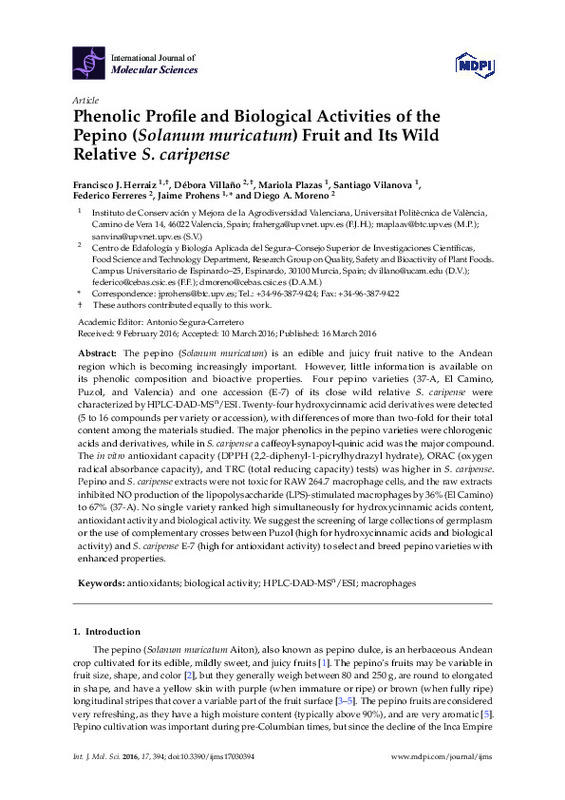JavaScript is disabled for your browser. Some features of this site may not work without it.
Buscar en RiuNet
Listar
Mi cuenta
Estadísticas
Ayuda RiuNet
Admin. UPV
Phenolic profile and biological activities of the fruit of pepino (Solanum muricatum) and its wild relative S. caripense
Mostrar el registro sencillo del ítem
Ficheros en el ítem
| dc.contributor.author | Herraiz García, Francisco Javier
|
es_ES |
| dc.contributor.author | Villaño, Débora
|
es_ES |
| dc.contributor.author | Plazas Ávila, María de la O
|
es_ES |
| dc.contributor.author | Vilanova Navarro, Santiago
|
es_ES |
| dc.contributor.author | Ferreres, Federico
|
es_ES |
| dc.contributor.author | Prohens Tomás, Jaime
|
es_ES |
| dc.contributor.author | Moreno, Diego A.
|
es_ES |
| dc.date.accessioned | 2018-01-30T06:52:02Z | |
| dc.date.available | 2018-01-30T06:52:02Z | |
| dc.date.issued | 2016 | es_ES |
| dc.identifier.uri | http://hdl.handle.net/10251/96042 | |
| dc.description.abstract | [EN] The pepino (Solanum muricatum) is an edible and juicy fruit native to the Andean region which is becoming increasingly important. However, little information is available on its phenolic composition and bioactive properties. Four pepino varieties (37-A, El Camino, Puzol, and Valencia) and one accession (E-7) of its close wild relative S. caripense were characterized by HPLC-DAD-MSn/ESI. Twenty-four hydroxycinnamic acid derivatives were detected (5 to 16 compounds per variety or accession), with differences of more than two-fold for their total content among the materials studied. The major phenolics in the pepino varieties were chlorogenic acids and derivatives, while in S. caripense a caffeoyl-synapoyl-quinic acid was the major compound. The in vitro antioxidant capacity (DPPH (2,2-diphenyl-1-picrylhydrazyl hydrate), ORAC (oxygen radical absorbance capacity), and TRC (total reducing capacity) tests) was higher in S. caripense. Pepino and S. caripense extracts were not toxic for RAW 264.7 macrophage cells, and the raw extracts inhibited NO production of the lipopolysaccharide (LPS)-stimulated macrophages by 36% (El Camino) to 67% (37-A). No single variety ranked high simultaneously for hydroxycinnamic acids content, antioxidant activity and biological activity. We suggest the screening of large collections of germplasm or the use of complementary crosses between Puzol (high for hydroxycinnamic acids and biological activity) and S. caripense E-7 (high for antioxidant activity) to select and breed pepino varieties with enhanced properties. | es_ES |
| dc.description.sponsorship | The authors express their gratitude to the Spanish Ministry of Economy and Competitiveness (MINECO) and the Iberian-American Program for Cooperation and Development (CYTED) (Ref. 112RT0460)-CORNUCOPIA Thematic Network (URL: redcornucopia.org). We are also grateful to Mariola Plazas and Pietro Gramazio for their technical assistance. | |
| dc.language | Inglés | es_ES |
| dc.publisher | MDPI AG | es_ES |
| dc.relation.ispartof | International Journal of Molecular Sciences | es_ES |
| dc.rights | Reconocimiento (by) | es_ES |
| dc.subject | Antioxidants | es_ES |
| dc.subject | Macrophages | es_ES |
| dc.subject | Biological activity | es_ES |
| dc.subject | HPLC-DAD-MSn/ESI | es_ES |
| dc.subject.classification | GENETICA | es_ES |
| dc.title | Phenolic profile and biological activities of the fruit of pepino (Solanum muricatum) and its wild relative S. caripense | es_ES |
| dc.type | Artículo | es_ES |
| dc.identifier.doi | 10.3390/ijms17030394 | es_ES |
| dc.relation.projectID | info:eu-repo/grantAgreement/CYTED//112RT0460//Seguridad, calidad y funcionalidad de alimentos: Retos de la innovación alimentaria en un mercado global/ | |
| dc.rights.accessRights | Abierto | es_ES |
| dc.contributor.affiliation | Universitat Politècnica de València. Departamento de Biotecnología - Departament de Biotecnologia | es_ES |
| dc.description.bibliographicCitation | Herraiz García, FJ.; Villaño, D.; Plazas Ávila, MDLO.; Vilanova Navarro, S.; Ferreres, F.; Prohens Tomás, J.; Moreno, DA. (2016). Phenolic profile and biological activities of the fruit of pepino (Solanum muricatum) and its wild relative S. caripense. International Journal of Molecular Sciences. 17(3). https://doi.org/10.3390/ijms17030394 | es_ES |
| dc.description.accrualMethod | S | es_ES |
| dc.relation.publisherversion | http://doi.org/10.3390/ijms17030394 | es_ES |
| dc.type.version | info:eu-repo/semantics/publishedVersion | es_ES |
| dc.description.volume | 17 | es_ES |
| dc.description.issue | 3 | es_ES |
| dc.identifier.eissn | 1422-0067 | es_ES |
| dc.identifier.pmid | 26999114 | |
| dc.identifier.pmcid | PMC4813249 | |
| dc.relation.pasarela | S\329567 | es_ES |
| dc.contributor.funder | Ministerio de Economía y Competitividad | |
| dc.contributor.funder | CYTED Ciencia y Tecnología para el Desarrollo |








